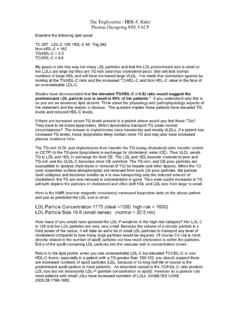Transcription of Drugs and HDL Subfractions - LipidCenter
1 Lipid Drugs and HDL Subfractions Thomas Dayspring MD, FACP. does it really matter what a drug does to HDL subparticles? HDL particle subpopulations and their physiologic flux (dynamic remodeling) is a continuous and complex process dependent on many variables. Since many practitioners are now doing advanced lipoprotein testing, they are obtaining and observing HDL particle baseline and follow up data. Many do not know how to interpret such data properly. Please review the diagrams at the end of the article Quick review: Since HDLs lipidate and then traffic sterols in several directions, including forward and reverse cholesterol transport (RCT) where they delipidate, a serum HDL-C.
2 Has little relationship with what HDL actually does . HDL or apoA-I mediated trafficking of cholesterol involves lipidation (acquiring lipids) and delipidation (giving up lipids) of HDL particles . Much of what an HDL does , after it acquires cholesterol can be considered as forward cholesterol transport (FCT). Any unwanted sterols can be returned in the RCT process to the liver or small intestine for further processing. RCT occurs via 3. pathways: 1) Unlipidated apoA1 or very small prebeta HDL particles are lipidated at the liver or small intestine or peripheral cells including arterial wall macrophages via ABCA1 transporters and then delipidated at steroid producing glands (adrenal or gonads) or adipocytes in the forward cholesterol transport pathway or at the liver via upregulated Scavenger Receptors B1 (SR-B1).
3 This part of the cholesterol flux process is termed direct RCT or apoA1 mediated RCT. The vast majority of the cholesterol trafficked within HDLs was acquired at the liver and jejunum. 2) Cholesteryl ester (CE) can be transferred in exchange for TG from apoB particles (LDL, IDL, and VLDL). The apoB particle, with the cholesterol just acquired from HDLs, can then be endocytosed by hepatic LDL receptors and deliver its cholesterol contents to the hepatocyte. This is termed indirect RCT or apoB. mediated RCT.
4 3) Large or small HDL can attach to arterial wall foam cells (macrophages) and delipidate the foam cell: small HDLs attach to ABCA1 and the more mature HDLs attach to ABCG1,G4 or SR-B1. This process termed macrophage RCT is crucial to stabilizing or delipidating plaque but contributes little to a plasma HDL- C level. This process has no effect on the total HDL-C concentrations as the amount of cholesterol delipidated from arterial wall foam cells is trivial compared to the amount of cholesterol HDLs acquire from hepatocytes and enterocytes.
5 The overwhelming majority of the cholesterol within HDL particle originates in the liver. Thus, 80-90% of the HDL-C level originates from the liver: not from peripheral cells or artery walls. Niacin does increase Total HDL-P (apoA-I) as well as the numbers of large HDL. particles . Neither LipoScience nor any governing body nor the FDA recommends HDL. particle concentration or size be a goal of therapy. The LipoScience report form properly states (based on good epidemiological data) that at baseline (in patients not on lipid Lipid Drugs and HDL Subfractions Thomas Dayspring MD, FACP.)
6 Modulating Drugs ) the lack of large HDL particles is a risk factor highly correlated with insulin resistance, small LDL and VLDL remnants. What explains the relationship between a lack of large HDL particles and atherogenic apoB particles ? Insulin resistant patients have increased TG carried in hepatic produced VLDL. Through cholesteryl ester transfer protein (CETP) mediated exchange (between HDL and VLDL) of TG for cholesteryl ester, the large cholesterol-rich HDL particles become TG-rich and cholesterol poor.
7 The lipolytic action of hepatic lipase hydrolyzes (removes) TG. and rapidly changes these large alpha HDL particles to much smaller alpha HDL which are subject to renal excretion due to their tiny diameter (5-7 nm): this is reflected by a reduced amount of both total and large HDL on the NMR LipoProfile test and decreased HDL-C on conventional lipid panels. When one treats at-risk patients with low HDL-C, the NCEP suggested target of therapy is not necessarily (although it is encouraged) to raise HDL-C or HDL subparticles to some magical level, but rather, to reduce the concentration of atherogenic apoB (LDL-P) or their NCEP surrogates (LDL-C.)
8 And Non HDL-C). NCEP makes no recommendations that one should attempt to make HDL particles large! NCEP and most experts will tell you that fractionation of HDL is not recommended at this time and has little role in current clinical practice as far as determining the efficacy of a drug . That being said, different Drugs do different things to HDL-C and HDL. subparticles. If a clinician is following HDL particles on follow up testing (NMR) the clinician had better do some serious reading and develop a thorough understanding of the topic.
9 The process of reverse cholesterol transport is a very complicated, dynamic flux, particle remodeling process that cannot be predicted from HDL-C levels or subparticle determination. Clinical trials demonstrate one can lower TG, lower apoB and reduce outcomes and in the process make HDL either large or small. It will depend on the particular therapy used. The bottom line is that CV risk reduction can occur independent of what happens to HDL particle size. Drugs that have outcome data in patients with low HDL-C include statins, fibrates and niacin.
10 The latter raises HDL-C more than the others but outcome data using any as a monotherapy is quite similar. To give you an idea on the complexity of HDL subparticles, please read on. The process of reverse cholesterol transport (RCT) is a flux process that involves many "players". some of which (to name just a few) include PPAR alpha, gamma and delta, hepatic, lipoprotein and endothelial lipase, LCAT, cholesteryl ester transfer protein, phospholipid transfer protein, scavenger receptors B1, CD-36, ABCA1 transporters, Liver X receptors, farnesol X receptors (FXR)sterol regulatory element binding proteins, hepatic and intestinal apoA-I, other apolipoproteins, cubilin and megalin, and LDL receptors.











